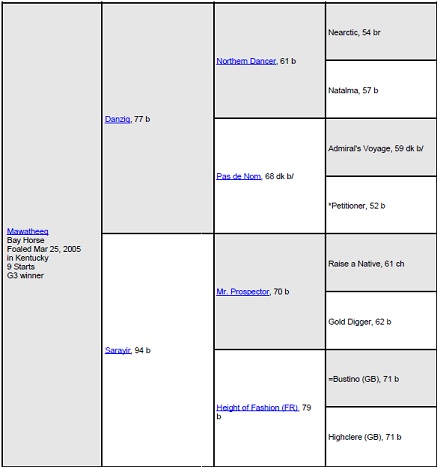I recently purchased a half share in a one eyed, two year old (who should make a nice three year old), for a four figure sum 🙂
Unsurprisingly, this expenditure got me curious about horses with partial blindness. There is no central data point to uncover listings of horses with this affliction, but I was able to compile the following listing of partially blind horses who had an impact on racing or breeding:
1. Dante (1942 Nearco ex Rosy Legend by Dark Legend).
Dante was the first Northern trained Derby winner since Pretender in 1869. He started suffering a decline in vision before the 2000 Guineas in which he was a narrow loser and was probably blind in his left eye at the time of that race. He was an unbeaten two year old, successful in the Coventry and Middle Park and the Guineas was his only defeat in 9 starts. He was being prepared for the St Leger but never ran again after the Derby.Dante enjoyed a good stud career (despite a relatively early death) with the likes of 2000 Guineas winner Darius and the Oaks winner Carozza to his credit.
2. Arctic Tern (1973 Seabird ex Bubbling Beauty by Hasty Road).
Arctic Tern came from the last crop of Sea Bird but came from a quality female line having Almahmoud as his grandam, a position she also occupied in the pedigrees of Northern Dancer and Halo. He was blind in his right eye but this did not impact on his racing career which saw him consistently competitive at the highest level. His 22 race career over three seasons saw him amass 4 victories with the highlight being a Group 1 victory to his credit in the 1977 Prix Ganay. He was also placed in that year’s Eclipse Stakes behind Artaius.
He did even better at stud, siring consecutive French Oaks winners in his first two crops (Harbour and Escaline), a Derby runner-up in Glacial Storm and best of all the outstanding Bering who would have been an undisputed champion most years but had the misfortune to be a contemporary of Dancing Brave.
3. Pollard’s Vision (2001 Carson City ex Etats Unis by Dixieland Band)
Pollard’s Vision was named after Ron Pollard best known these days as Seabiscuit’s one eyed jockey. A decent career saw him win the Grade II Illinois Derby and later finish runner up in the Pimlico Special. He made a big start to his stud career with the outstanding filly (and wonderfully named) Blind Luck (Pollard’s Vision ex Lucky One by Best of Luck) , being a member of his first crop. However, to date he has failed to sire anything comparable to Blind Luck.
4. Among the vision impaired fillies, The Dancer (1977 Green Dancer ex Khazaeen by Charlottesville ) won the May Hill Stakes and finished third to Bireme in the 1980 Oaks. At stud she produced a high class performer in Mack the Knife (by Kris) who finished runner up in the Racing Post Trophy.
5. Mention of Kris leads us neatly to Moon Cactus (1987 Kris ex Lady Moon by Mill Reef ) who came even closer to classic success having finished runner up in the French Oaks to Rafha (also by Kris and even more famous as the dam of Invincible Spirit and Kodiac). Moon Cactus did achieve stakes success in the Prestige Stakes and Sweet Solera Stakes .She proved a top class broodmare producing the 1995 Oaks winner Moonshell (by Sadler’s Wells) and her full brother the impressive 2004 King George winner Doyen. She had restricted vision in her left eye.
6. Among National Hunt horses Winning Fair (1955 by Fun Fair ex Winning Hazard by Atout Maitre) was only partially sighted but it didn’t prevent him from winning the 1963 Champion Hurdle. As a gelding Winning Fair obviously had no breeding legacy but his trainer was George Spencer who is the father of top jockey Jamie Spencer. Many punters have also questioned Jamie’s eyesight over the years :)….
7. Among current runners, the Aidan O’Brien trained Eye of the Storm (2010 Galileo ex Mohican Princess by Shirley Heights) won last year’s Group 3 Ballyroan Stakes.
Infirmities of old age often mean horses lose their sight but they can continue to have breeding success. The outstanding stallion Monsun (Konigsstuhl ex Mosella by Surumu) was blind in the latter stages of his career as were a number of prominent broodmares. Among the celebrated broodmares who went blind in later life (which typically meant their foals wore a bell so that they knew of their presence) were Floripedes, the dam of Montjeu and Park Express the dam of New Approach. Lord Derby’s, Samanda who was blinded as foal became grandam of Ouija Board and Teleprompter.
Conclusion:
It’s easy to imagine that horses might have difficulties with tight right or left handed tracks depending on which eye was lost. Similarly, they might be at a disadvantage if challenged on their blindside. However each case is different and it is difficult to evaluate just how much of a handicap sight loss is to a horse. All we can say is that the above examples prove it is not an insurmountable obstacle. I suspect my horse is far more likely to fail from lack of speed than lack of sight in one eye, but I titled this piece blind optimism and I can only hope that I might soon be adding his name to the above list of notables.
